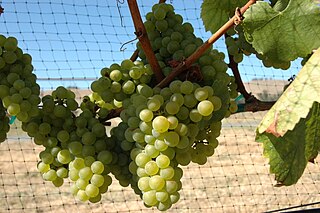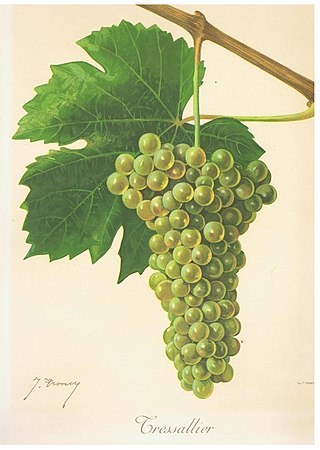
Chardonnay is a green-skinned grape variety used in the production of white wine. The variety originated in the Burgundy wine region of eastern France, but is now grown wherever wine is produced, from England to New Zealand. For new and developing wine regions, growing Chardonnay is seen as a 'rite of passage' and an easy entry into the international wine market.

Pinot noir is a red-wine grape variety of the species Vitis vinifera. The name may also refer to wines created predominantly from pinot noir grapes. The name is derived from the French words for pine and black. The word pine alludes to the grape variety having tightly clustered, pinecone–shaped bunches of fruit.

Blaufränkisch is a dark-skinned variety of grape used for red wine. Blaufränkisch, which is a late-ripening variety, produces red wines which are typically rich in tannin and may exhibit a pronounced spicy character.

Aligoté is a white grape used to make dry white wines, especially in the Burgundy region of France where it was first recorded in the 18th century. Since it is tolerant to cold, this variety is also cultivated in Eastern European countries. In 2004, it was the 22nd most planted vine variety in the world at 45,000 hectares.

Gouais blanc or Weißer Heunisch is a white grape variety that is seldom grown today but is important as the ancestor of many traditional French and German grape varieties. The name Gouais derives from the old French adjective ‘gou’, a term of derision befitting its traditional status as the grape of the peasants. Likewise, the German name Weißer Heunisch labels it as one of the lesser "Hunnic" grapes.
Romorantin is a traditional French variety of white wine grape, that is a sibling of Chardonnay. Once quite widely grown in the Loire, it has now only seen in the Cour-Cheverny. It produces intense, minerally wines somewhat reminiscent of Chablis.

Sacy is a white wine grape grown primarily in the central and northeastern France within the Yonne and Allier départments.

Auxerrois blanc or Auxerrois Blanc de Laquenexy is a white wine grape that is important in Alsace, and is also grown in Germany and Luxembourg. It is a full sibling of Chardonnay that is often blended with the similar Pinot blanc.
Meslier Petit is a rare white wine grape that is a minor component of some Champagne blends. It is valued for its ability to retain acidity even in hot vintages. In the very rare cases where it is not blended, it makes crisp wines tasting of apples. The Traminer family of grapes can be difficult to grow, with poor disease resistance and low yields.
Bachet noir is a traditional French variety of red wine grape that is a sibling of Chardonnay. A little is still grown in the Aube, where it is used to add colour and body to Gamay wines.

Beaunoir is a traditional French variety of red wine grape that is a sibling of Chardonnay. The 'beautiful black' grape produces a thin wine and not much is grown these days.
Franc Noir de la Haute-Saône is a traditional French variety of red wine grape that is a sibling of Chardonnay. It makes thin, tart wine and has largely disappeared from cultivation.
Gamay Blanc Gloriod is an obscure French variety of white wine grape. Very little of it is grown commercially.
Knipperlé is a traditional French variety of white wine grape from Alsace. It's not listed for use in AOC wine, but is a minor component of blends for local drinking, in some ways an Alsatian equivalent of its sibling Aligoté in Burgundy.

Roublot is a traditional French variety of white wine grape that is a sibling of Chardonnay. It was once quite widely grown near Auxerre.
Dameron is a traditional French variety of red wine grape that is a sibling of Gamay. Its wines are somewhat weightier than Gamay, but it is disappearing from its traditional areas in northern France. Not much is grown in France these days.
Aubin vert is a white French wine grape variety that is grown in the Lorraine region where it is an authorized variety for the Appellation d'Origine Contrôlée (AOC) wines of the Moselle. While often confused for the Côtes de Toul grape Aubin blanc, DNA analysis in 1999 showed that Aubin vert was the result of a crossing of Gouais blanc with Pinot. This makes the grape a half-sibling to Aubin blanc but full sibling to Chardonnay, Aligoté, Gamay and Melon de Bourgogne.

Gouget noir is a red French wine grape variety that is grown in the Allier and Cher departments of central France. The grape was once widely planted with almost 17,000 hectares in the mid-19th century but the phylloxera epidemic greatly diminished it numbers and as of 2008 there was just 10 hectares of the grape planted in France.
Canari noir is a red French wine grape variety that has been historically grown in the Ariège department in the foothills of the French Pyrénées. However DNA profiling in 2001 showed that plantings of a grape called Gamay Luverdon growing in the Italian wine region of Piedmont were in fact plantings of Canari noir. Across the Pyrénées in Spain, the grape variety known as Batista was also found to be identical to Canari noir. Like Pinot noir and Grenache, Canari noir has color mutations known as Canari blanc and Canari gris.
Gueuche noir is a red French wine grape variety that has been historically grown in the Franche-Comté of eastern France but is now close to being extinct. Though its exact relationship has not yet been determined by DNA analysis, ampelographers believe that the grape variety is closely related to the Hunnic grape Gouais blanc which is notable for being the mother vine to several grape varieties including Chardonnay and Gamay. There also might be a relationship between Gueuche noir and the Jura wine grape Enfariné noir.










